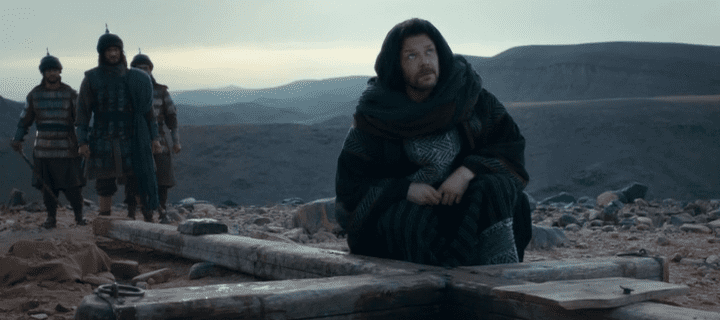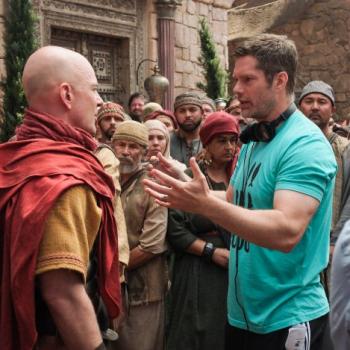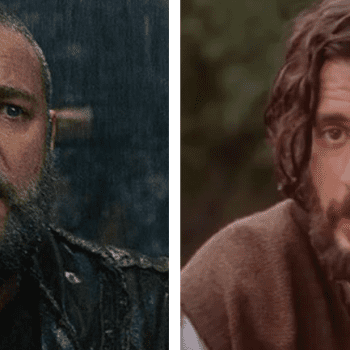Note: Between now and mid-June, I will be writing short recaps of each episode of A.D. The Bible Continues for Christianity Today Movies. You can read the first recap here. Time permitting, I will also post extra thoughts at this blog, like so:
Season 1, Episode 1 — ‘The Tomb Is Open’
Mark 14-15, Matthew 26-28, Luke 22-23, John 18-19
The same, but different. A.D. The Bible Continues has been billed as a sequel to The Bible, but The Bible went all the way to the end of Revelation, whereas A.D. begins with the crucifixion and resurrection of Jesus and will go on to cover the first ten chapters of the book of Acts. So the new series is really more of a reboot.
Thus, the first episode of A.D. begins where the eighth episode of The Bible ended: with the trial of Jesus before Caiaphas and the Sanhedrin.
Except it’s not just the Sanhedrin who pass judgment on Jesus this time, it’s an entire crowd. And when Jesus is taken to Pilate in the next scene, the entire trial there takes place before a crowd as well. This is a dramatic change from most other films — including The Bible — which have tended to show the trials taking place indoors, with Pilate occasionally stepping outside to address the mob, as per John’s gospel.1
But this series needs to get through the trials and crucifixion of Jesus as quickly as it can, so that it can spend more time developing the show’s main characters. So it merges the trial scenes with the crowd scenes, just to speed things along.
Interestingly, in its haste, the show leaves out the story from Luke’s gospel about Pilate sending Jesus to Herod Antipas, as well as the story from all four gospels about Pilate letting the rebel Barabbas go free instead of Jesus.
These are interesting omissions, given that the producers have been saying all along that they want to explore the political dynamics of first-century Judea, from the friction between the priests, kings and governors on the one hand to the outright violence between the Romans and the Zealots on the other hand.
We do know that Antipas, at least, will appear in future episodes.
The show probably doesn’t have any room for Barabbas, though: the first episode shows the Romans fretting over the fact that the Zealots have started to use the buzz around Jesus as a recruiting tool, and it would probably make things a wee bit too complicated if Pilate himself had just set one of the insurrectionists free.
One other significant difference between this show and The Bible is the way it turns different minor figures from the Bible into major supporting characters.
The Bible developed Nicodemus as a member of the Sanhedrin who initially supports Caiaphas but eventually switches to Jesus’ side. It also turned Malchus — the temple guard whose ear was cut off by Peter — into a recurring character who goes on to be involved with the Sanhedrin’s actions against the apostles a la Acts.
But Nicodemus and Malchus are nowhere to be seen in this episode of A.D. Instead, the roles they played are filled by Joseph of Arimathea and Cornelius.
Joseph, of course, is the other member of the Sanhedrin who was loyal to Jesus — and when he reveals to Caiaphas that Jesus is buried in his tomb, I was surprised to realize that it had never occurred to me before to wonder how Caiaphas might have reacted when he first learned about this. After all, if the high priests asked Pilate to put a guard around the tomb, they surely must have known whose tomb it was.2
Meanwhile, A.D. turns Cornelius — a Roman centurion who is mentioned only in Acts 10 — into a character who combines aspects of The Bible’s treatment of Nicodemus and Malchus. Like Malchus, he is an assistant to one of the story’s chief antagonists, in this case Pilate, and he plays a significant part in the death of Jesus, as the centurion who oversees his execution and burial. And like Nicodemus, we know that he will eventually switch sides, becoming the first Gentile convert to the faith.
There are a few potential problems with developing Cornelius this way, though.
For one thing, the Cornelius of this episode seems like basically just another violent Roman: there is no hint of the righteous Gentile in Acts 10 who prays and gives generously to the poor even before he becomes a Christian.
Also, when Peter preaches to Cornelius’s family in Acts 10, he tells them the story of Jesus’ execution as though they might not have heard it before — but the Cornelius of this series won’t need to be told how it happened because he’s the one who made it happen. “They killed him by hanging him on a cross,” says the Peter of the Bible, but the Peter of the series could just as easily say, “You killed him…”
Another key difference between this show and The Bible is that this show actually places an angel outside the tomb at the Resurrection.
The angel himself does resemble the “warrior angels” that we saw in The Bible, though. He is even played by Lonyo Engele, who played one of the two sword-wielding angels who attack the men of Sodom before the city is destroyed in The Bible. As before, he draws his sword — but this time, instead of attacking anyone with it, he just holds it where the Romans can see it, presumably because it looks “cool”.3
Two other similarities worth noting: Pilate’s wife tells him he’ll “live to regret” killing Jesus, just as she did in The Bible, and Joseph of Arimathea sings prayers in Hebrew as Jesus’ body is prepared for burial, just as Nicodemus did in The Bible.
Scripture references. Obviously, this episode takes most of its narrative material from the passion narratives in the gospels. But it makes interesting use of other scriptures as well.
For example, in one early scene after the trial in Pilate’s palace, Caiaphas is talking to his wife Leah, his father-in-law Annas and his colleague Joseph of Arimathea — and Caiaphas says, “The life of one man is as nothing, Joseph, for the sake of God’s nation.” That’s a clear nod to what Caiaphas tells his fellow priests in John 11:50.
Just a few minutes later, Caiaphas quotes Psalm 28 while praying to God in the Temple, and as he gets to the words “Hear my cry for mercy,” the film cuts to a shot of Jesus on the cross. One of the things I liked about The Bible was the way it showed the Jewish leaders and the pagan Romans being just as devout in their own religious practices as the Christians are in theirs, and scenes like this indicate A.D. might go that route as well. Plus there’s a fascinating irony in the way Caiaphas prays to God — for mercy, even — while the Son of God is being killed at Caiaphas’s behest.
Later, it is Leah’s turn to quote the Old Testament. When Joseph reveals that Jesus is buried in his tomb, a stunned Leah quotes Isaiah 53:9 — “And he made his grave with the wicked and his tomb with the rich” — while her husband accuses Joseph of inadvertently fulfilling a prophecy. I don’t know if the Jews of this period would have seen that passage as a prophecy specifically, or if the passage was simply interpreted as a reference to Jesus after the fact, but it’s an interesting nod, just the same.
Finally, when Boaz the Zealot tells Peter and the other Christians that they should join the revolution, Peter replies, “Live by the sword and you die by the sword,” which is basically what Jesus said to Peter after Peter cut off Malchus’s ear mere hours before the events of this episode. A.D. never mentions the ear-cutting, though, which means we never get a sense of just how tempted by the sword the biblical Peter was.
Harmonization. Reuben, the head of the temple guard, tells Caiaphas that Judas has been found dead in “the potter’s field.” That’s an interesting quasi-harmonization of the two very different accounts of Judas’s death in the Bible.
Matthew 27 says Judas hanged himself, and it says the priests bought “the potter’s field” with the money that Judas returned to them, but it does not say that Judas died in the potter’s field itself. Acts 1, on the other hand, says Judas himself bought the field and died there when he “fell headlong” and “all his intestines spilled out.”
So A.D. basically follows Matthew’s narrative (will we see the priests buy the field in a future episode?) but takes the location of Judas’s death from Acts.
Two earthquakes! A handful of films, such as Cecil B. DeMille’s The King of Kings, Pier Paolo Pasolini’s The Gospel According to St. Matthew and Mel Gibson’s The Passion of the Christ, have shown an earthquake striking Jerusalem when Jesus dies, as per Matthew 27. But apart from the Visual Bible’s word-for-word adaptation of Matthew, I can’t think of any other film that has shown an earthquake striking when the angel comes down and rolls the stone away from the tomb, as per Matthew 28.
A.D., being a show that goes for the spectacle whenever it can, has both.
Family matters. It’s easy to forget sometimes that the people we read about in the Bible, and in secular history, had families who are often not mentioned in the texts.
So I like the fact that this episode not only introduces Caiaphas’s wife Leah, but it also shows Caiaphas sending his children off to bed. Caiaphas, we see, is a family man. Most of Leah’s scenes so far consist of her getting all snooty about Jesus and his “simplistic homilies”, but there’s a scene near the end where she asks Caiaphas to come to bed, and I hope we get more moments of domestic realism like that.
Meanwhile, in another scene, Simon the Zealot — who is actually one of the apostles and is not, so far as we can see, an insurrectionist like Boaz — says they should all go back to Galilee now because their duty is to their families.4
We don’t see any evidence of these families in this episode, but we know from the trailers and whatnot that future episodes will pay particular attention to Peter’s relationship with his daughter, as well as the marriages of characters like Joanna, who has not yet been introduced. So that’s something to look forward to.
I do wish Pilate and his wife would do more than bicker about Jesus, though.
Political dynamics. Given how reticent the priests were to enter Pilate’s palace in John 18 — and given how the Jews as a whole were dominated by the Romans during this period — it’s a little startling to see Caiaphas walk right into Pilate’s office to demand that Pilate put a guard around Jesus’ tomb.
Would the historical Caiaphas have been so bold? Would the historical Pilate have tolerated such impudence? I doubt it, but you never know.
I do get a slight kick out of the way Pilate grants the requests of both Caiaphas and Joseph of Arimathea as a way of deliberately keeping the Jewish elders “at each other’s throats,” as he puts it, and then shrugs and says “It never crossed my mind” when Caiaphas says Pilate must have known the friction this would cause.
The Pilate of both biblical and secular history loved to snub the Jewish leaders whenever he could, so this seems perfectly in keeping with his character.
Apologetics. One of the really striking things about this episode, to me, is how the dialogue includes a few lines which seem almost designed to make a Lee Strobel-style argument for the death and resurrection of Jesus.
Pilate asks Cornelius if he is really, really, really certain that Jesus is dead, and Cornelius, of course, says that he’s a Roman who knows how to do his job, and that if anyone said Jesus was alive after all this, then they would be “either mad or a fool.” I doubt that Pilate himself felt the need to clarify all this with his own officers, so this dialogue feels like it was aimed at modern, possibly skeptical, viewers.
And of course, the discussion of fulfilled prophecy between Caiaphas, Leah and Joseph of Arimathea fits into this apologetic framework too.
Relics. I like the way Caiaphas, concerned that the myth of Jesus might not die with his body, tells his men to remove the cross and break it up. He’s trying to get rid of anything that the followers of Jesus might cling to.
I’m curious now to see what he — or the Christians themselves, for that matter — will do with the burial clothes of Jesus and anything else that might be associated with the Resurrection when they find the empty tomb in next week’s episode.
Theological points. I like how the episode cuts from the crucifixion of Jesus to the priests splashing the blood of the Passover lambs on the altar. The timing of the crucifixion — the fact that it coincides with the killing of the lambs — is implicit in John’s gospel, so it’s good to see that connection made visually here.
I also like how John, the one disciple who actually witnessed the crucifixion, tells the other disciples exactly how Jesus died, and then says, “It doesn’t matter that you weren’t there. He understood our weakness. He loved us for it. Died for it.”
This reminds me of a passage in Robert Jewett’s Saint Paul Returns to the Movies: Triumph Over Shame on the meaning of Paul’s statement in Romans 5:6 that Christ died for us “while we were still weak.” Jewett notes that some commentators have been puzzled by Paul’s “seemingly untheological and overly ‘mild’ choice of the term weak in this sentence,” but Jewett argues that the concept would have resonated very strongly within the honour-shame dynamic of first-century Rome.
Odds and ends. I hate to say it, but I agree with the Slate article which said that the Jesus of this series lacks “charisma”. The actor’s performance in the trial scenes does nothing for me. But I very much like the sense of agony and helplessness that he brings to the crucifixion scenes, even the way he sort of nervously looks to the side in anticipation of the first nail going through his hand. It seems to me that films are getting better at conveying the sheer horror of being crucified, even when that horror is felt by the Son of God, and this episode is a good example of that.
And I’m sympathetic to those who find the sequence with the angel and the empty tomb “kitschy” a la the works of Thomas Kinkade.
Having the angel fall to Earth like a meteor — just like the fallen angels in Noah! — is particularly odd. It looks kind of cool and all, but do angels really announce themselves like this when they travel? Acts 1 seems to indicate that a couple of angels surprised the apostles by just kind of appearing out of nowhere; their appearance wouldn’t have been so “sudden” if they had left trails of smoke coursing through the air, like rockets burning up on re-entry, as they came down to Earth.
But I like the scenes in which Mary and the apostles share their grief and argue over what to do next. Scenes like these give the characters a chance to breathe in a way that The Bible never quite did, and I look forward to seeing where they go from here.
–
1. Interestingly, Luke’s gospel is the only one that specifies that Jesus was taken “into the house of the high priest”, but it is also the only one that specifies that Jesus “turned and looked straight at Peter” after Peter denied knowing him. So apparently, even if Jesus was indoors, it didn’t mean he was hidden from view.
2. Interestingly, Matthew’s gospel is the only one that says a guard was put around Jesus’ tomb — and it is also the only one that doesn’t mention Joseph’s connection to the Sanhedrin. (John doesn’t mention it explicitly either, but he does say that Joseph buried Jesus with help from Nicodemus, who is identified in John’s gospel as a member of the Sanhedrin.) So none of the gospels draw even implicit attention to the clash between different members of the Sanhedrin over what to do with Jesus’ body.
3. Two years ago, I wondered if The Bible omitted the angels from its depiction of the Resurrection and the Ascension because the “white robes” described in the biblical version of those stories didn’t match the red cloaks that the angels had worn when they appeared to Abraham, Joshua, Mary and others in earlier episodes. A.D. resolves this by having the “warrior angels” wear white cloaks over their armour.
4. Ironically, the actor who plays Simon the Zealot in A.D. The Bible Continues — Fraser Ayres — also played Barabbas in The Bible, who was at least a rebel if not a full-fledged Zealot.
–
CT Movies recaps: one | two | three | four | five | six | seven | eight | nine | ten | eleven | twelve
FilmChat recaps: one | two | three | four | five | six | seven | eight | nine | ten | eleven | twelve













